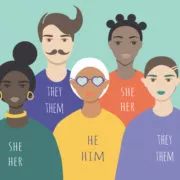BLOOM has found interACT to be an invaluable resource in regards to education and advocacy for individuals with intersex traits. All our information on intersex was sourced from interACT. To learn more visit their website: InteractAdvocates.org.
Intersex is an umbrella term for differences in sex traits or reproductive anatomy.
Intersex people are born with these differences or develop them in childhood. There are many possible differences that can occur in genitalia, hormones, internal anatomy, or chromosomes, compared to the usual two ways that human bodies develop.
Some intersex traits are noticed at birth. Others don’t show up until puberty or later in life.
Intersex individuals often face shame — or are forced or coerced into changing their bodies, usually at a very young age. Most surgeries to change intersex traits happen in infancy.
Like any child, an intersex infant can be raised socially as a boy or a girl without unnecessary surgery.
Decisions around surgery that are not life-saving should be delayed.
The word intersex also invokes a community.
Intersex people are diverse, coming from all socioeconomic backgrounds, races, ethnicities, genders and orientations, faiths, and political ideologies.
Intersex individuals are united by:
- the experiences of living with variations in sex traits
- the belief that these differences are a natural part of human diversity
- the idea that people deserve their own choices about their own bodies
How common is intersex?
How many intersex people are born each year? What are the statistics? Even in countries where most births happen in hospitals, these are hard questions to answer. This is largely because no one is required to track this information. But we do know that being intersex is more common than one might think.
About 1.7% of people are born intersex (compare that to a ~0.3% chance of having identical twins). One in 2,000 babies (0.05% of humans) are born with genital differences that a doctor might suggest changing with unnecessary surgery.
These estimates are based on work by Dr. Anne Fausto-Sterling, who reviewed medical literature from 1955-1998 (Sexing the Body: Gender Politics and the Construction of Sexuality, 2000).
What does intersex look like?
There is no way to “look” intersex. Every person is different. There are over 40 medical terms for the different ways sex anatomy might develop. Here are a few examples, and their common traits:
How do I know if I’m intersex?
Could a person be intersex without knowing it? Without a medical diagnosis? Maybe. It has certainly happened before.
These are the most common ways for a person to notice that their body is different.
- At birth, when another person sees genital differences
- At puberty, when changes happen too early, in unexpected ways, or not at all
- In adulthood, when infertility or other problems reveal internal differences
- In adulthood, after learning that adults covered up childhood medical interventions
Most intersex people can point to recognizable patterns in their bodies and social experiences. These patterns generally hold up across different groups of intersex people, and across medical terms for different intersex variations.
Gender & Intersex
Being intersex is different from being transgender or nonbinary. Someone who is transgender has a gender (such as male, female, or nonbinary) that is different from what was assumed when they were born. Someone who is intersex developed one or more bodily characteristics that don’t fit neatly into stereotypes about “male” or “female” bodies. Someone can be both intersex and transgender, but being intersex doesn’t automatically make someone transgender or nonbinary, just like being transgender or nonbinary doesn’t mean that someone is intersex.
Resoures & Support for Intersex Persons
Welcome to the community! You are not alone. There are many intersex support groups, often on Facebook, where intersex people come together to connect. There is also InterConnect who hosts a yearly in-person conference in the United States. Visit Intersex Organizations – interACT for known intersex groups in other countries.
Intersex Support Groups on Facebook (publicly searchable):
- interACT offers iSpace, a Facebook peer support group for people ages 13 to 29.
- There is a support group for caregivers of intersex children, www.facebook.com/groups/IntersexPS of all ages and locations.
- Intersex Fam is a general Facebook discussion group for intersex people AND allies.
In the meantime, if you need more support, interACT has worked with the following organizations that serve LGBTQIA+ youth, and who have some knowledge and exposure to intersex issues.
- Trans Lifeline, TransLifeline.org
- The Trevor Project, TheTrevorProject.org
- NIRP (Nonbinary and Intersex Recognition Project), NIRP.us
- GLSEN (for high school and younger), GLSEN.org
Additional interACT Intersex Resources
- What We Wish Our Parents Knew
- What We Wish Our Friends Knew
- What We Wish Our Teachers Knew
- What We Wish Our Doctors Knew
- Intersex Resource Topics







